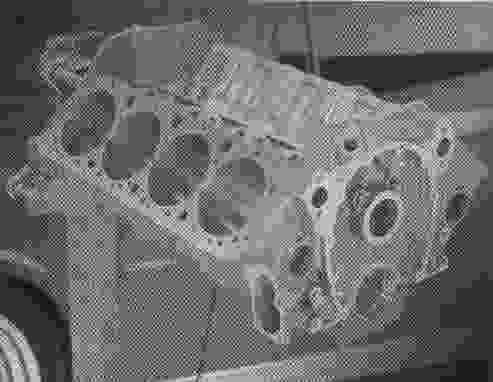| A hot-looking induction system, a set of good-flowing
cylinder heads, and a strong cam. All these components have something in
common. They're all bolted to an engine block that at one time began as a
drawing. Since many of the performance characteristics of any engine
depend on its block configuration, engineers must take into account an
almost endless list of design criteria. The number of cylinders, bore
size, stroke, vehicle design, and casting material must all be considered
before designing an engine. Let's take a look at the cylinder block for
this month's Bow-Tie Basics. » |
速そうな吸気システム、流れのいいシリンダーヘッドと強いカムの組み合わせ。これらの組み合わせは共感のあるところである。これらは全て最初は図面であったエンジンブロックに装着されている。あらゆるエンジンの多くの性能の違いはそのブロックの定義に影響を受けるため、エンジニアはほとんど無限にある設計要素のリストを考慮に入れなければならない。シリンダーの数、ボアのサイズ、ストローク、車のデザイン、鋳込む材料などは全てエンジンを設計する前に熟考されなければならない。今月のボータイベーシックとしてシリンダーブロックについて見てみよう。 |
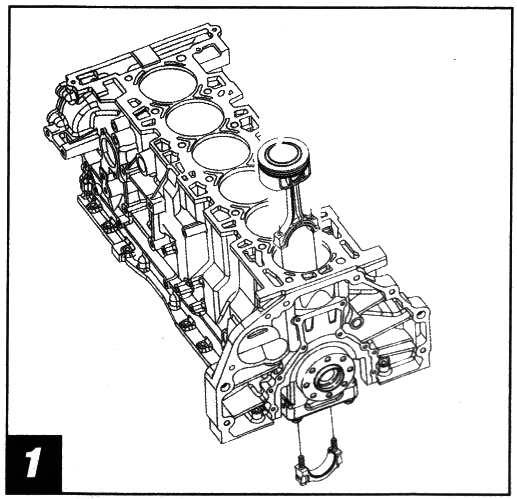 1
The Cylinder Block 1
The Cylinder Block
The block forms the basic framework of the engine where heat energy
is converted into mechanical energy inside the cylinders. To do this,
pistons inside the cylinders perform an up-and- down action while sealing
cylinder pressure. The moving piston must also allow only a minimum amount
of friction and wear from the sliding motion. To permit this, the cylinder
wall must be as round as possible. |
1 シリンダーブロック
ブロックは、シリンダーの中で熱エネルギーが機械的エネルギーに変わる場所であるエンジンの基本的な骨格を形成する。そのために、シリンダーの中のピストンはシリンダーの圧力を密閉しながら上下動を行う。また、動作中のピストンにはその摺動から起きる最小の摩擦と最小の磨耗しか許されない。このためにシリンダー壁は可能な限り滑らかでなければならない。 |
Strength in Numbers
Typically, most automotive engines have four, six, or eight cylinders and
are categorized by the number of cylinders and block configuration. These
block configurations include inline, V, and horizontally opposed
variations. |
数字の強さ
たいていの場合ほとんどの自動車のエンジンは4,6,8気筒のいずれかでシリンダーの数とブロック定義で分類される。ブロック定義は直列、V型、そして水平対抗の種類を含む。 |
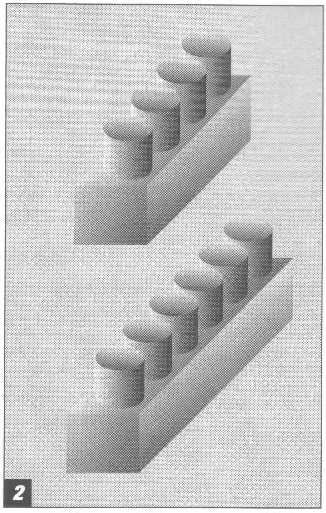 2
InlIne Engine 2
InlIne Engine
On an inline engine, the cylinders are arranged in a straight row, mounted
vertically. Today's inline engine is typically a four or six cylinder.
Since the cylinders are mounted vertically, the engine generally requires
more underhood space. Therefore, the hood and front fenders are designed
taller to accommodate an inline engine, which lessens the body's
aerodynamic qualities.
|
2.直列エンジン
直列エンジンでは、シリンダーは直線状に並べられ、縦にマウントされる。今日の直列エンジンはたいてい4気筒か6気筒である。縦にマウントされるため、このエンジンは一般的にボンネット下のスペースを必要とする。そのためにフードとフロントフェンダーは直列エンジンにスペースを提供するために背が高めにデザインされる、そしてそのことが車体の空力性能を悪化させる。 |
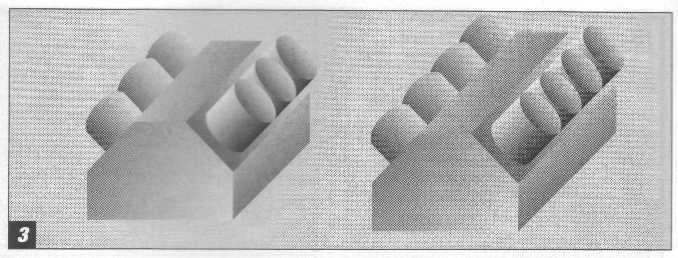
3 V-Type
V-type engine blocks usually have six, eight, or ten cylinders arranged in
two rows with an angle of 60 degrees or 90 degrees between the cylinder
banks.
Typically, the cylinders on both banks slant toward the crankshaft.
Chevrolet V-8 and V-6s slant at a 90-degree angle. V-type engine
advantages include a short length, great block rigidity, and a low
profile.
Semi-even-Fire V-6s
Chevrolet engineers produced the 90-degree
V-6 by removing the No. 3 and No. 6 cylinders from a small-block Chevy
design. For vehicle production, Chevrolet offered a semi-even— fire
engine in 200ci and 229ci displacements along with a 262ci even-fire
engine. The semi-even—fire engine incorporated a pair of adjacent
connecting rods that shared a crankshaft throw, and the respective rod
journals were offset 18 degrees. This provided a firing sequence at 132
and 108 degrees throughout the engine's firing order. Consequently, the
semi-even—fire engine was not the smoothest-running engine on the
block. Unlike the semi-even—fire 200ci and 229ci V-6 engines, the
262ci even-fire V-6 did provide a uniform firing sequence.
|
3.V型
V型エンジンは通常6,8,10気筒が2つの列に60度あるいは90度の角度のシリンダーバンクを挟んで並べられる。
通常、両方のバンクのシリンダーがクランクシャフトを軸として傾いている。シボレーのV8とV6は90度角である。V型エンジンの利点は短い全長、ブロックの頑丈さ、そして背の低さである。
不等間隔爆発V-6
シボレーのエンジニアはシボレースモールブロックの3番シリンダーと6番シリンダーを除去して90度V6を作った。車両の生産のために、シボレーは200ciと229ci排気量の不等間隔爆発エンジンと262ciの等間隔爆発エンジンを提供した。不等間隔爆発エンジンは一組のクランクシャフトスローを共有する近接したコンロッドを組み込まれ、それぞれのロッドジャーナルは18度ずらされている。これによりエンジン全体の点火順の中で点火の間隔は132度と108度になっている。そのため不等間隔爆発エンジンは滑らかに回るエンジンではなかった。不等間隔爆発エンジンの200ci,229ciと異なり、262ci等間隔V6では統一された点火の間隔となっている。
|
 4
Horizontally Opposed 4
Horizontally Opposed
In 1960, Chevrolet designed a horizontally opposed air-cooled engine
for the Corvair. With this design the cylinders are arranged horizontally,
opposed to each other, producing an engine with a low overall height.
This blended well with the Corvair's unique dynamics and low body line.
Horizontally opposed engines have the lower part of the cylinder block
formed into a crankcase to house the crankshaft, camshaft, and valvetrain.
In an opposed-type block, the pistons are mounted horizontally across from
each other at a 180-degree angle. The engine is sometimes referred to as a
"boxer" because of the back-and-forth motion the pistons travel.
|
4.水平対抗
1960年シボレーは水平対抗空冷エンジンをCorvairのためにデザインした。(訳注:VW、ポルシェが売れているからという安直な理由としか思えない。Corvair=Corvette+Air
Cooled)このデザインはシリンダーを水平に並べ、お互いに反対向きに向かい合わせ、高さの低いデザインのエンジンを作る。これがCorvairの独特な形と低いボディラインとうまく調和した。水平対抗エンジンはシリンダーブロックの下部がクランクシャフト、カムシャフト、バルブトレインを収納するクランクケースの中に組み合わされる。対向型ブロックでは、ピストンは水平に互いに180度の角度で反対を向いて位置する。このエンジンはそのピストンの前後に動く動きから時々”ボクサー”と言われる。 |
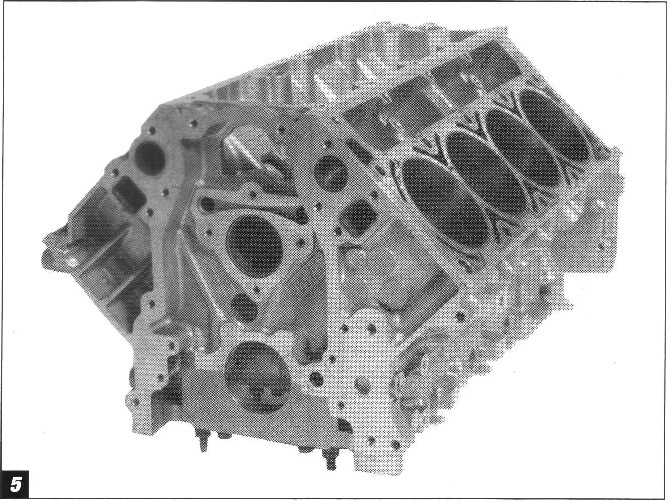
5 Metal Mania
For decades, most blocks have been made of cast iron. But during the last
several years, manufacturers started using aluminum-alloy blocks to reduce
weight. But because aluminum is a soft metal, most aluminum blocks incorporate a cast-iron cylinder liner to provide long service. For durability,
the cylinder liners must have a specific hardness, a low coefficient of
friction, and thermal stability to provide long trouble-free service. Most
aluminum blocks today incorporate either a cast-in or a pressed-in
cylinder liner.
|
5 メタルマニア
何十年もの間、ほとんどのブロックは鋳鉄で作られてきた。しかし、最近の数年は製造者はアルミニウム合金ブロックを軽量化のために使い始めている。しかしアルミニウムは柔らかい金属であるため、ほとんどのアルミニウムブロックは鋳鉄のシリンダーライナーを耐久性向上のために組み合わせて利用している。耐久性を考えた時、長期にわたるトラブルのない働きのために、シリンダーライナーは特定の硬さ、低い摩擦係数、そして熱安定性を持たなければならない。 ほとんどのアルミシリンダーは鋳込みあるいは圧入したシリンダーライナーと組み合わされている。
|
|
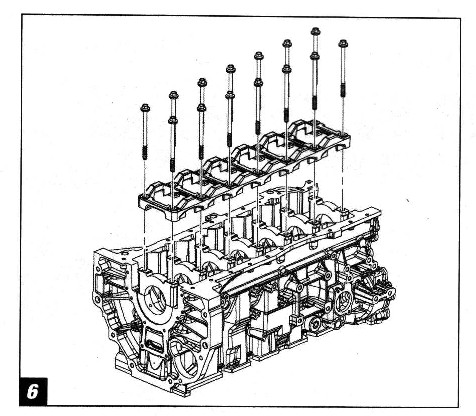
6 The Main Idea
Main caps support an engine's rotating assembly (i.e. crankshaft,
connecting rods, and pistons) and provide rigidity to the block. Most
Chevy V-8s feature main caps retained with two-bolts, while
high-performance blocks often use four bolts. Due to crankshaft length
and design, an inline six-cylinder generally uses seven main caps while
a V-8 uses five. To precisely position the crankshaft, all main-bearing
caps are fitted with bearing inserts at each crankshaft journal. These
inserts allow an oil film to form over the crankshaft journals, reducing
friction. Critical to the main cap's design and operation is oil
clearance and crankshaft end-play. If the main-cap bearing clearance is
too small, excessive heat will be generated, thus causing bearing and
crankshaft damage. If the clearance is too great, the crankshaft can
hammer the bearing and cause engine failure. The rear main- cap bearing by design provides
limited fore-and-aft movement (end-play) of the crankshaft.
|
6 メインアイデア(訳注:主たるアイデアとメインボルトのアイデアをかけている)
メインキャップはエンジンの回転部分(つまりクランクシャフト、コンロッド、そしてピストン)を支え、ブロックの安定性をもたらす。ハイパフォーマンスブロックがしばしば4つのボルトを使う一方、大部分のシェビーV8のメインキャップは2ボルトにとどまっている。クランクシャフトの長さとデザインへの制約から、直列6気筒では通常7つのメインキャップを使い、V-8は5つ使う。クランクシャフトの位置を正確に定めるため、全てのメインベアリングキャップは各々のクランク車夫とジャーナルにおいてベアリングインサートとフィットされなければならない。これらのインサートはクランクシャフトジャーナル上に油膜を作らせ、摩擦を軽減する。メインキャップのデザインと作業にとって重要なことはオイルクリアランスとクランクシャフトエンド遊びである。もしメインキャップベアリングの間隔が小さすぎると、余計な熱が発生され、結果としてベアリングとクランクシャフトを傷める。間隔が大きすぎると、クランクシャフトはベアリングを打撃しエンジンを壊してしまう。リアメインキャップベアリングはデザインによってクランクシャフトに制約された前後動(エンド遊び)を与えるようになっている。
|
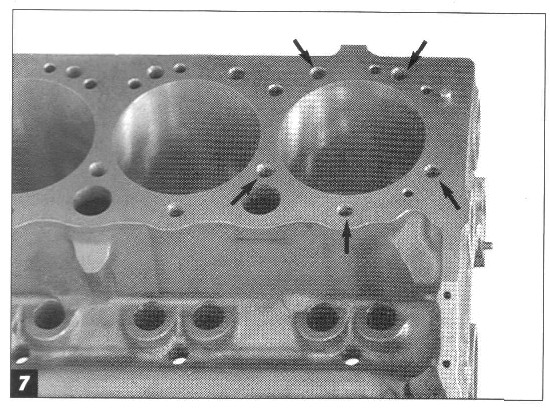
7 Head bolts per cylinder
Cylinder-head sealing is critical in block
configuration. To provide even clamping and minimize the chance of
warpage, engineers designed the original small- block Chevy with five
cylinder-head bolts surrounding each cylinder to seal the combustion
area. Each small-block head uses a total of 17 head bolts. The Gen III
LS1 engine now employs only four bolts per cylinder for a total of 10
head bolts. |
7シリンダーあたりのヘッドボルト
シリンダーへットシーリングはブロックの設定にとって非常に重要である。均一な抑え力を与え、反りや歪みの危険性を最小にするために、エンジニアはオリジナルスモールブロックシェビーを燃焼空間を密閉するシリンダーごとの周囲のボルトを5個にデザインした。スモールブロックのヘッドはそれぞれ計17のヘッドボルトを使っている。第三世代LS1エンジンはシリンダーあたり4つだけで、合計で10個のヘッドボルトを使っている。 |

8 Give 'Em Space
Bore spacing primarily determines the length of an engine. Shown above
is a big-block (left) and a small-block (right). Notice
the big-block is longer
than the small-block. Bore size, connecting-rod width, and main-bearing
width all contribute to an engine's overall dimensions. Clearly, a wider
bore spacing allows larger bores and greater displacement. Also notice
that the left cylinder banks (on both engines) are farther forward than
the right banks. This allows each connecting-rod journal to be
positioned on center with its respective cylinder bore.
|
8 間隔を与えよ
ボア間隔はエンジンの長さに最も影響する。上に示したのはビックブロック(左)とスモールブロック(右) ボックブロックのボアサイズはスモールブロックより大きいことに注目。ボアサイズ、コンロッド幅、メインベアリング幅は全てエンジンの全体サイズに影響する。より広いボア間隔は明白に、より大きいボアと大きい排気量を可能にする。それから、左側のシリンダーバンクが右側よりもずっと前にあることにも注目。これによってそれぞれのコンロッドジャーナルはそれぞれのシリンダーボアの中心に位置することができる。 |
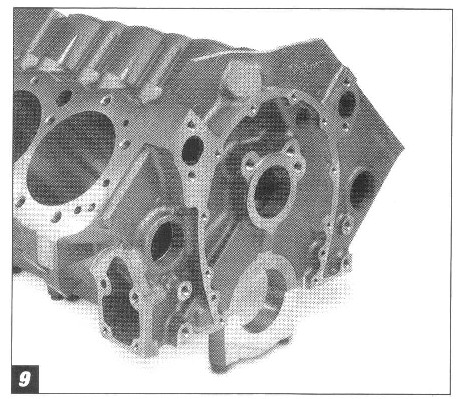
9 Fluid Dynamics
Besides precisely locating all the major internal components, the block
is also responsible for fluid distribution for both the lubrication and
cooling systems. We'll use the small-block V8 engine as our example for
both the oil and water ways.
For the lubrication system, oil begins in the pan and is pressurized by
the oil pump and pushed past the main cap and out to the oil filter. Oil flows down the outside of the filter, through the
filter media to the inside where it is then forced up an angled passage in the
bell-housing area to the main oil galley down the middle of the block on top of
the cam journals. If you look at a bare block with the cam bearings removed,
you'll see passages around each of the five cam journals that direct oil to the
mains. Oil is then pushed around the cam journals down to the main journals in
the block. The hole in the main web feeds oil to the crankshaft where it then is
directed to the rod journals. Here it leaks past the rods, is whipped by the
crank and splash lubricates the cam lobes (and you thought the lobes were
pressure-fed, didn't you?).
The main oil passage in the lifter valley also feeds two parallel oil galleys
that run through the middle of the lifters. These passages feed oil to the
lifters and also travel up through the pushrods to lubricate the rocker arms,
valvesprings, and the rest of the valvetrain. From here, the oil drains back
through passages in the head and block to return to the oil pan where the
process starts all over again.
For the cooling system, Chevy engines pick up coolant from the radiator through
the lower radiator hose and pressurize the coolant with the pump. The liquid
then enters the block and travels down both sides of the block past the
cylinders through water jackets cast into the block. The coolant travels from
the front to the back of the block and then enters the cylinder heads at the
rear, travelling forward. Coolant passages are also cast into the cylinder
heads, directing water especially around the combustion chamber and the exhaust
valves to help pre vent detonation.
Once the coolant reaches the front of the cylinder head, the water enters the
intake manifold just beneath the thermostat. The thermostat's job is to restrict
flow until the coolant temperature reaches a minimum temperature. The valve then
opens and the coolant is then pushed by water pump pressure back to the radiator
where the process starts all over again.
The LT1 and LT4 Gen II small-blocks were designed around a reverse cooling
system where coolant is directed first through the cylinder heads and then
through the block to further improve cylinder head cooling. When the LS1 Gen Ill
small-block was designed; however, it returned to the original coolant flow
path. CHP
|
9 液体力学
全ての主要な部品を厳密に正しく設置することに加え、ブロックは潤滑と冷却双方の液体についても重要である。スモールブロックV8をオイルと水の両方の道についての例として用いる。
潤滑系では、オイルはパンの中でスタートし、オイルポンプで加圧され、メインキャップを押し通されオイルフィルターへと出て行く。オイルはフィルターの外側を流れ降り、フィルター媒体を通って内側へと流れる、そこではそれからカムジャーナルの上、ブロック中央にあるメインオイルギャラリーへとベルハウジング空間の中のアングルパッセージを押し上げられる。もし剥き出しのブロックをカムベアリング無しで見たら、5個のカムジャーナルそれぞれの周りにオイルをメインへと導く道筋を見ることができるだろう。オイルはそれからカムジャーナルの周りを押し下げられブロックのメインジャーナルへと向かう。メインの巣の中の穴はオイルをクランクシャフトへ、そしてそれからロッドジャーナルへと供給する。ここでロッドを通って漏れた分はクランクによって飛ばされ飛沫がカムローブを潤滑する。(あなたはローブは圧力供給だと思っていたんじゃないですか?)
リフターバレーの中のメインオイル流路はまたリフターの中を通る2つの並行したオイルギャレーへも供給する。これらの流路はリフターにオイルを共有し、さらにプッシュロッドを通ってロッカーアーム、バルブスプリング、そしてバルブトレインの残りを潤滑する。ここからは、オイルはヘッドとブロックの中の道を通ってオイルパンへと落ちていく、そしてオイルパンではまた全ての繰り返しが始まる。
冷却系では、シェビーエンジンはクーラントをラジエーターからロアーラジエーターホースを通して吸い上げポンプで圧力化する。それからその液体はブロックに入り、そしてシリンダーを通過してブロックの中に鋳込まれたウォータージャケットを通ってブロックの両サイドを流れ落ちる。クーラントはブロックの中を前から後ろへと流れ、それからシリンダーヘッドへ後部で入り前方へと流れる。クーラント流路はまた、シリンダーヘッドへも鋳込まれてあり、水を特に燃焼室の周りと排気バルブへと導き、デトネーションを避ける助けとなる。
クーラントがシリンダーヘッドの全部へと到達したら、水はインテークマニホールドへサーモスタット直下から入る。サーモスタットの仕事は水温が最低温度に到達するまで流れを制限することである。弁はそれから開き、クーラントはそれからウォーターポンプの水圧によってラジエーターへと戻される、そしてそこでまた全てが繰り返され始める。
LT1とLT4の第二世代スモールブロックではリバースクーリングシステム、より発展したシリンダーヘッド冷却のためクーラントが最初にシリンダーヘッドへと直接流れそれからブロックへと流れるシステムに設計された。しかし、LS1第三世代エンジンが設計された時には、元の流れに戻された。(訳注:リバースフローではヘッド冷却が著しく向上する反面、他の部分の冷却能はかなり落ちる。ヘッドで吸収した熱を他の部分で放熱してからラジエーターに達するので、あまり賢い方法ではない。) |
